BSc Business Management: Types of Companies and Structures Report
VerifiedAdded on 2022/11/28
|9
|2538
|322
Report
AI Summary
This report, submitted by a student, provides an overview of different types of companies, ranging from micro-businesses to large corporations, and explores their operational characteristics. It examines various business structures, including sole proprietorships, partnerships, and limited liability businesses, along with their implications. The report also delves into organizational structures, such as functional and divisional structures, and their impact on business productivity. Furthermore, it applies a PESTLE analysis to Tesco, a multinational corporation, to understand how political, economic, social, technological, environmental, and legal factors influence its performance. The report concludes by emphasizing the importance of business structures and external factor analysis for achieving competitive advantage and ensuring long-term sustainability. The report is available on Desklib, a platform offering AI-based study tools for students.
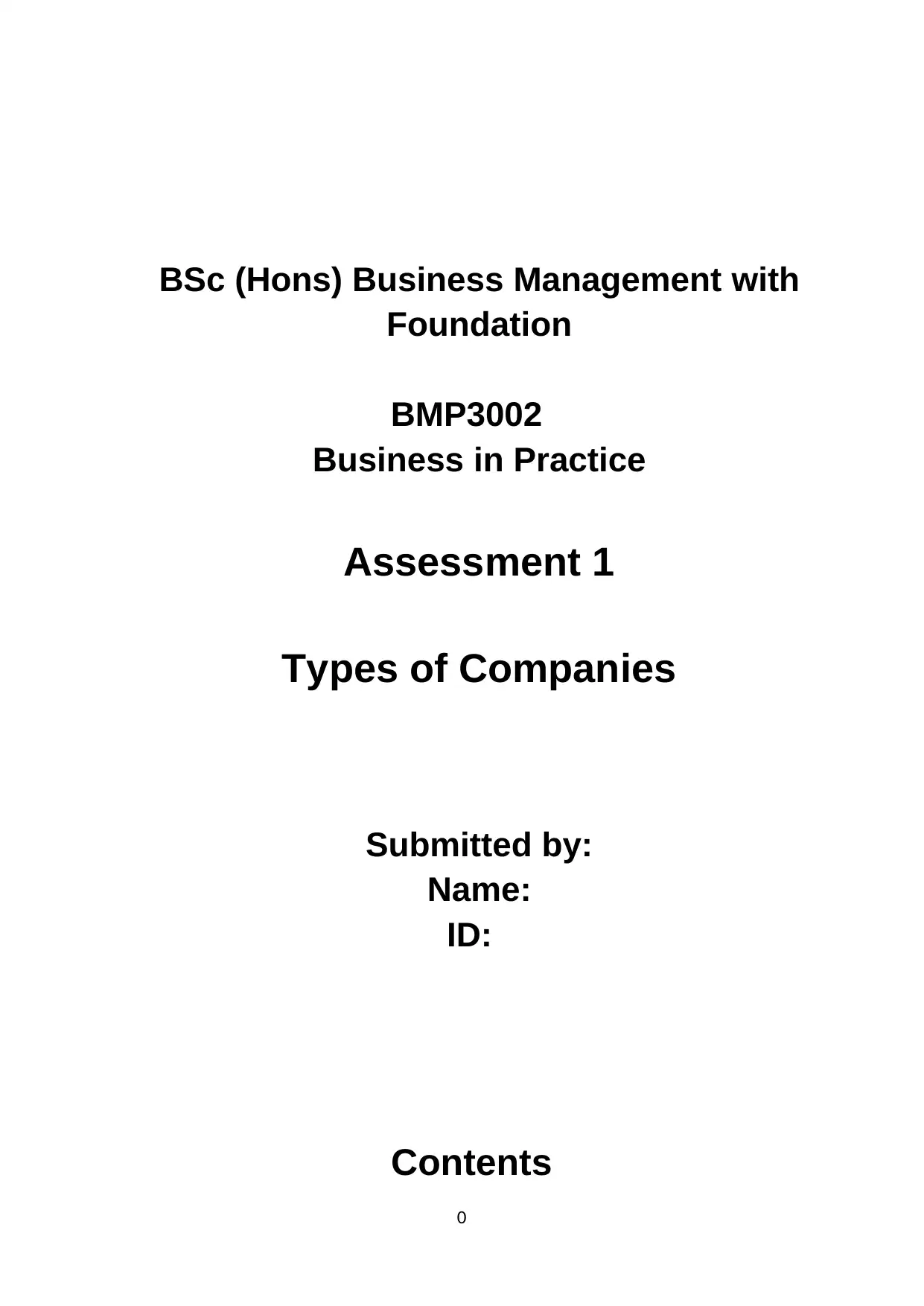
BSc (Hons) Business Management with
Foundation
BMP3002
Business in Practice
Assessment 1
Types of Companies
Submitted by:
Name:
ID:
Contents
0
Foundation
BMP3002
Business in Practice
Assessment 1
Types of Companies
Submitted by:
Name:
ID:
Contents
0
Paraphrase This Document
Need a fresh take? Get an instant paraphrase of this document with our AI Paraphraser
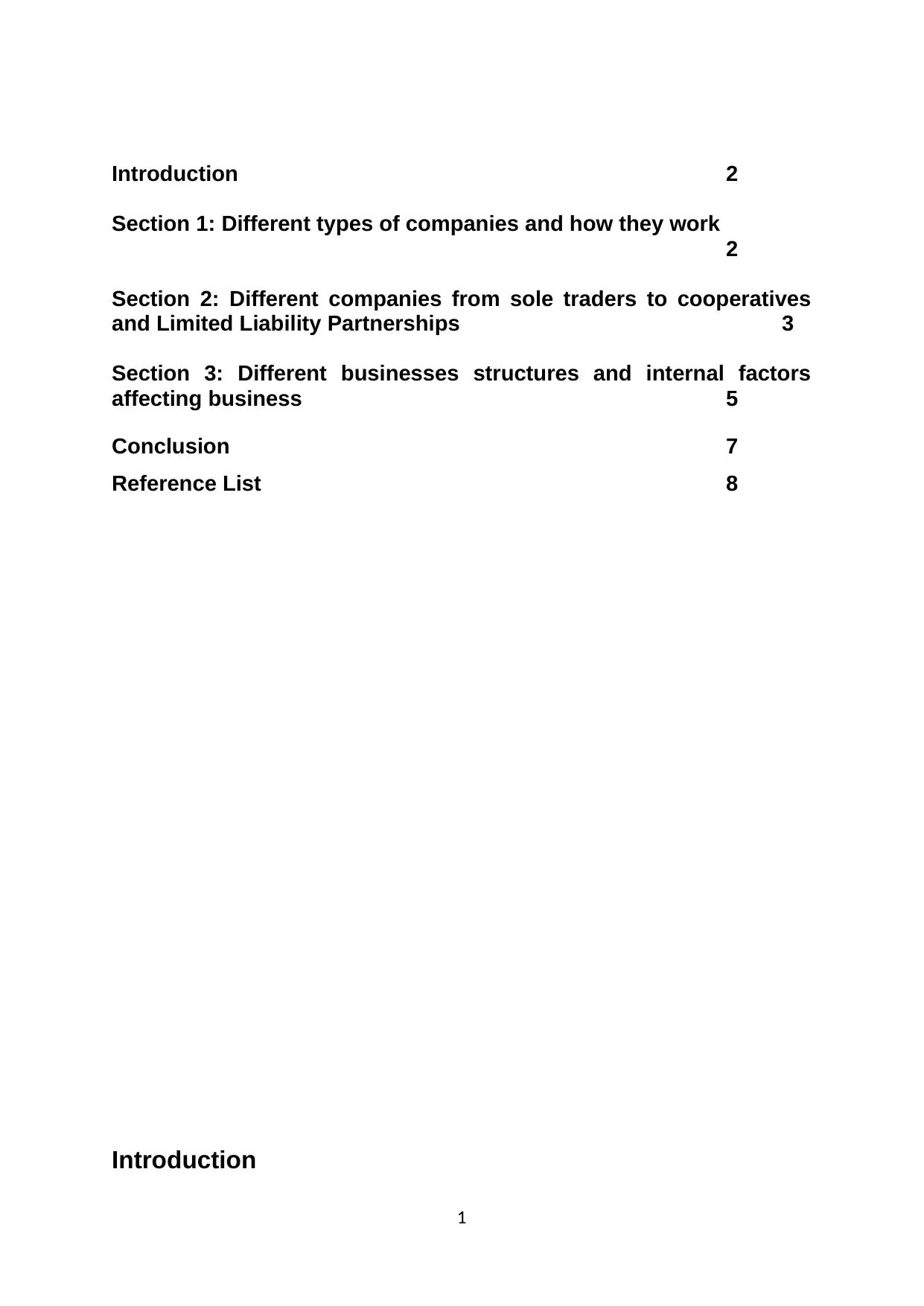
Introduction 2
Section 1: Different types of companies and how they work
2
Section 2: Different companies from sole traders to cooperatives
and Limited Liability Partnerships 3
Section 3: Different businesses structures and internal factors
affecting business 5
Conclusion 7
Reference List 8
Introduction
1
Section 1: Different types of companies and how they work
2
Section 2: Different companies from sole traders to cooperatives
and Limited Liability Partnerships 3
Section 3: Different businesses structures and internal factors
affecting business 5
Conclusion 7
Reference List 8
Introduction
1
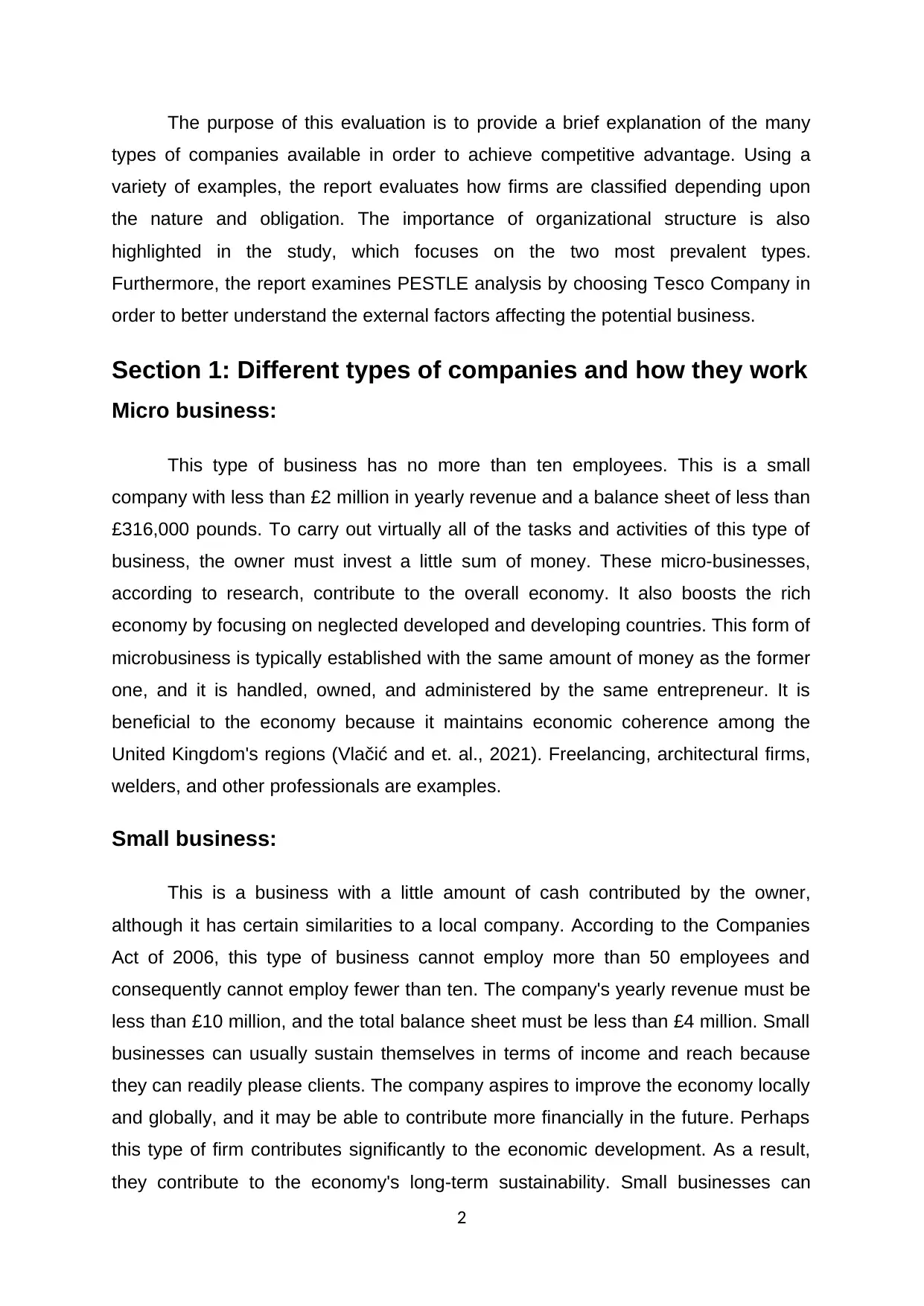
The purpose of this evaluation is to provide a brief explanation of the many
types of companies available in order to achieve competitive advantage. Using a
variety of examples, the report evaluates how firms are classified depending upon
the nature and obligation. The importance of organizational structure is also
highlighted in the study, which focuses on the two most prevalent types.
Furthermore, the report examines PESTLE analysis by choosing Tesco Company in
order to better understand the external factors affecting the potential business.
Section 1: Different types of companies and how they work
Micro business:
This type of business has no more than ten employees. This is a small
company with less than £2 million in yearly revenue and a balance sheet of less than
£316,000 pounds. To carry out virtually all of the tasks and activities of this type of
business, the owner must invest a little sum of money. These micro-businesses,
according to research, contribute to the overall economy. It also boosts the rich
economy by focusing on neglected developed and developing countries. This form of
microbusiness is typically established with the same amount of money as the former
one, and it is handled, owned, and administered by the same entrepreneur. It is
beneficial to the economy because it maintains economic coherence among the
United Kingdom's regions (Vlačić and et. al., 2021). Freelancing, architectural firms,
welders, and other professionals are examples.
Small business:
This is a business with a little amount of cash contributed by the owner,
although it has certain similarities to a local company. According to the Companies
Act of 2006, this type of business cannot employ more than 50 employees and
consequently cannot employ fewer than ten. The company's yearly revenue must be
less than £10 million, and the total balance sheet must be less than £4 million. Small
businesses can usually sustain themselves in terms of income and reach because
they can readily please clients. The company aspires to improve the economy locally
and globally, and it may be able to contribute more financially in the future. Perhaps
this type of firm contributes significantly to the economic development. As a result,
they contribute to the economy's long-term sustainability. Small businesses can
2
types of companies available in order to achieve competitive advantage. Using a
variety of examples, the report evaluates how firms are classified depending upon
the nature and obligation. The importance of organizational structure is also
highlighted in the study, which focuses on the two most prevalent types.
Furthermore, the report examines PESTLE analysis by choosing Tesco Company in
order to better understand the external factors affecting the potential business.
Section 1: Different types of companies and how they work
Micro business:
This type of business has no more than ten employees. This is a small
company with less than £2 million in yearly revenue and a balance sheet of less than
£316,000 pounds. To carry out virtually all of the tasks and activities of this type of
business, the owner must invest a little sum of money. These micro-businesses,
according to research, contribute to the overall economy. It also boosts the rich
economy by focusing on neglected developed and developing countries. This form of
microbusiness is typically established with the same amount of money as the former
one, and it is handled, owned, and administered by the same entrepreneur. It is
beneficial to the economy because it maintains economic coherence among the
United Kingdom's regions (Vlačić and et. al., 2021). Freelancing, architectural firms,
welders, and other professionals are examples.
Small business:
This is a business with a little amount of cash contributed by the owner,
although it has certain similarities to a local company. According to the Companies
Act of 2006, this type of business cannot employ more than 50 employees and
consequently cannot employ fewer than ten. The company's yearly revenue must be
less than £10 million, and the total balance sheet must be less than £4 million. Small
businesses can usually sustain themselves in terms of income and reach because
they can readily please clients. The company aspires to improve the economy locally
and globally, and it may be able to contribute more financially in the future. Perhaps
this type of firm contributes significantly to the economic development. As a result,
they contribute to the economy's long-term sustainability. Small businesses can
2
⊘ This is a preview!⊘
Do you want full access?
Subscribe today to unlock all pages.

Trusted by 1+ million students worldwide
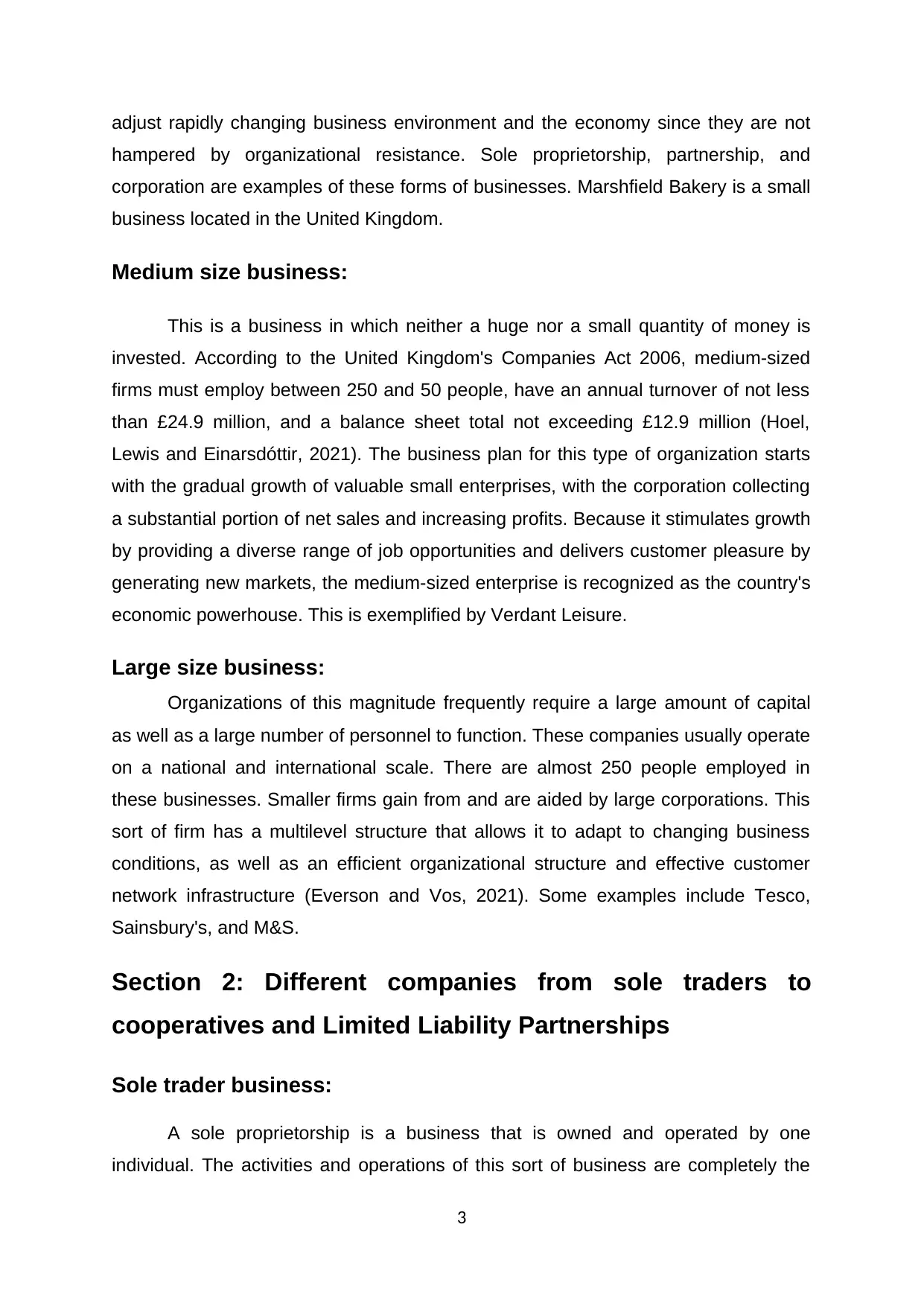
adjust rapidly changing business environment and the economy since they are not
hampered by organizational resistance. Sole proprietorship, partnership, and
corporation are examples of these forms of businesses. Marshfield Bakery is a small
business located in the United Kingdom.
Medium size business:
This is a business in which neither a huge nor a small quantity of money is
invested. According to the United Kingdom's Companies Act 2006, medium-sized
firms must employ between 250 and 50 people, have an annual turnover of not less
than £24.9 million, and a balance sheet total not exceeding £12.9 million (Hoel,
Lewis and Einarsdóttir, 2021). The business plan for this type of organization starts
with the gradual growth of valuable small enterprises, with the corporation collecting
a substantial portion of net sales and increasing profits. Because it stimulates growth
by providing a diverse range of job opportunities and delivers customer pleasure by
generating new markets, the medium-sized enterprise is recognized as the country's
economic powerhouse. This is exemplified by Verdant Leisure.
Large size business:
Organizations of this magnitude frequently require a large amount of capital
as well as a large number of personnel to function. These companies usually operate
on a national and international scale. There are almost 250 people employed in
these businesses. Smaller firms gain from and are aided by large corporations. This
sort of firm has a multilevel structure that allows it to adapt to changing business
conditions, as well as an efficient organizational structure and effective customer
network infrastructure (Everson and Vos, 2021). Some examples include Tesco,
Sainsbury's, and M&S.
Section 2: Different companies from sole traders to
cooperatives and Limited Liability Partnerships
Sole trader business:
A sole proprietorship is a business that is owned and operated by one
individual. The activities and operations of this sort of business are completely the
3
hampered by organizational resistance. Sole proprietorship, partnership, and
corporation are examples of these forms of businesses. Marshfield Bakery is a small
business located in the United Kingdom.
Medium size business:
This is a business in which neither a huge nor a small quantity of money is
invested. According to the United Kingdom's Companies Act 2006, medium-sized
firms must employ between 250 and 50 people, have an annual turnover of not less
than £24.9 million, and a balance sheet total not exceeding £12.9 million (Hoel,
Lewis and Einarsdóttir, 2021). The business plan for this type of organization starts
with the gradual growth of valuable small enterprises, with the corporation collecting
a substantial portion of net sales and increasing profits. Because it stimulates growth
by providing a diverse range of job opportunities and delivers customer pleasure by
generating new markets, the medium-sized enterprise is recognized as the country's
economic powerhouse. This is exemplified by Verdant Leisure.
Large size business:
Organizations of this magnitude frequently require a large amount of capital
as well as a large number of personnel to function. These companies usually operate
on a national and international scale. There are almost 250 people employed in
these businesses. Smaller firms gain from and are aided by large corporations. This
sort of firm has a multilevel structure that allows it to adapt to changing business
conditions, as well as an efficient organizational structure and effective customer
network infrastructure (Everson and Vos, 2021). Some examples include Tesco,
Sainsbury's, and M&S.
Section 2: Different companies from sole traders to
cooperatives and Limited Liability Partnerships
Sole trader business:
A sole proprietorship is a business that is owned and operated by one
individual. The activities and operations of this sort of business are completely the
3
Paraphrase This Document
Need a fresh take? Get an instant paraphrase of this document with our AI Paraphraser
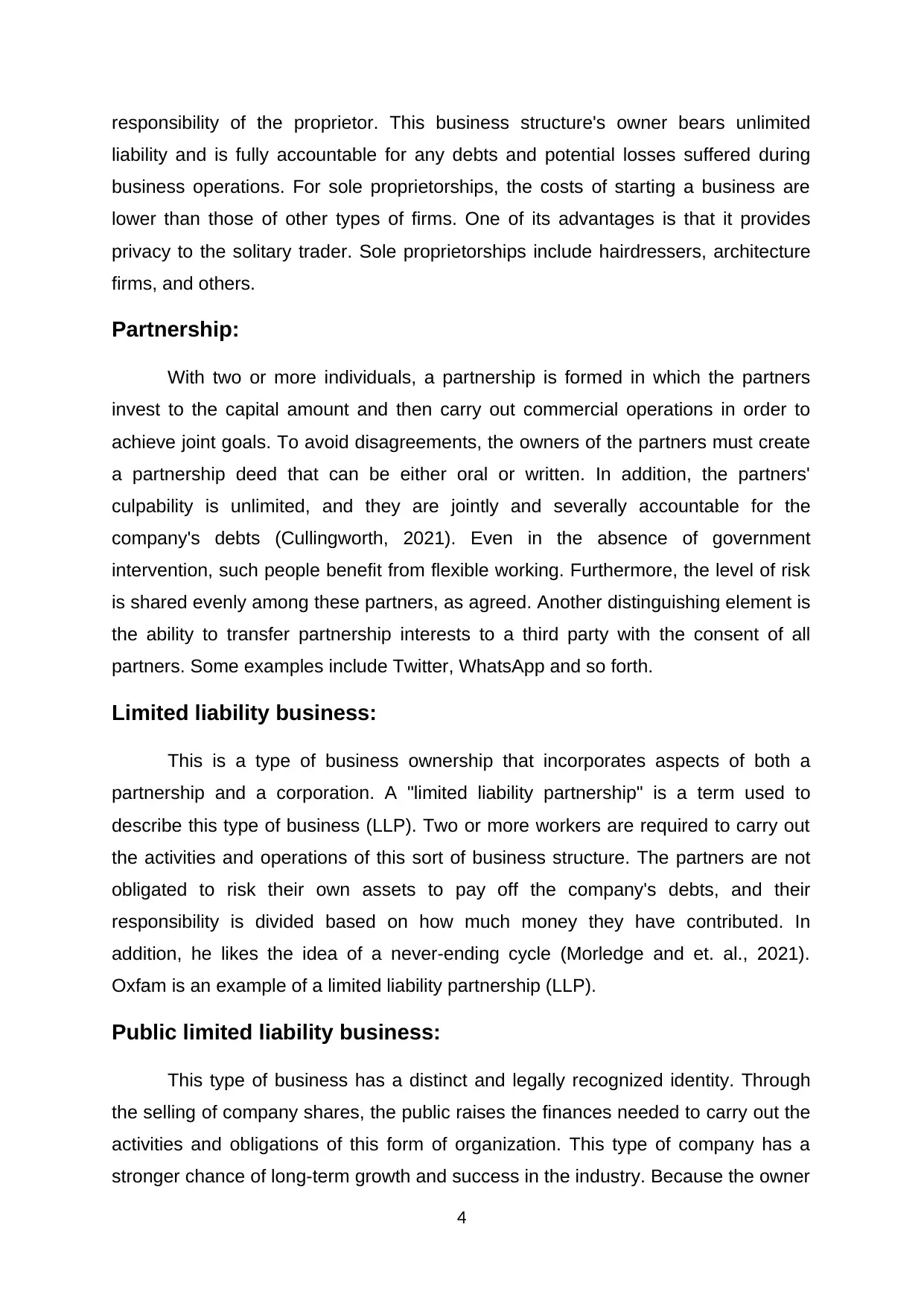
responsibility of the proprietor. This business structure's owner bears unlimited
liability and is fully accountable for any debts and potential losses suffered during
business operations. For sole proprietorships, the costs of starting a business are
lower than those of other types of firms. One of its advantages is that it provides
privacy to the solitary trader. Sole proprietorships include hairdressers, architecture
firms, and others.
Partnership:
With two or more individuals, a partnership is formed in which the partners
invest to the capital amount and then carry out commercial operations in order to
achieve joint goals. To avoid disagreements, the owners of the partners must create
a partnership deed that can be either oral or written. In addition, the partners'
culpability is unlimited, and they are jointly and severally accountable for the
company's debts (Cullingworth, 2021). Even in the absence of government
intervention, such people benefit from flexible working. Furthermore, the level of risk
is shared evenly among these partners, as agreed. Another distinguishing element is
the ability to transfer partnership interests to a third party with the consent of all
partners. Some examples include Twitter, WhatsApp and so forth.
Limited liability business:
This is a type of business ownership that incorporates aspects of both a
partnership and a corporation. A "limited liability partnership" is a term used to
describe this type of business (LLP). Two or more workers are required to carry out
the activities and operations of this sort of business structure. The partners are not
obligated to risk their own assets to pay off the company's debts, and their
responsibility is divided based on how much money they have contributed. In
addition, he likes the idea of a never-ending cycle (Morledge and et. al., 2021).
Oxfam is an example of a limited liability partnership (LLP).
Public limited liability business:
This type of business has a distinct and legally recognized identity. Through
the selling of company shares, the public raises the finances needed to carry out the
activities and obligations of this form of organization. This type of company has a
stronger chance of long-term growth and success in the industry. Because the owner
4
liability and is fully accountable for any debts and potential losses suffered during
business operations. For sole proprietorships, the costs of starting a business are
lower than those of other types of firms. One of its advantages is that it provides
privacy to the solitary trader. Sole proprietorships include hairdressers, architecture
firms, and others.
Partnership:
With two or more individuals, a partnership is formed in which the partners
invest to the capital amount and then carry out commercial operations in order to
achieve joint goals. To avoid disagreements, the owners of the partners must create
a partnership deed that can be either oral or written. In addition, the partners'
culpability is unlimited, and they are jointly and severally accountable for the
company's debts (Cullingworth, 2021). Even in the absence of government
intervention, such people benefit from flexible working. Furthermore, the level of risk
is shared evenly among these partners, as agreed. Another distinguishing element is
the ability to transfer partnership interests to a third party with the consent of all
partners. Some examples include Twitter, WhatsApp and so forth.
Limited liability business:
This is a type of business ownership that incorporates aspects of both a
partnership and a corporation. A "limited liability partnership" is a term used to
describe this type of business (LLP). Two or more workers are required to carry out
the activities and operations of this sort of business structure. The partners are not
obligated to risk their own assets to pay off the company's debts, and their
responsibility is divided based on how much money they have contributed. In
addition, he likes the idea of a never-ending cycle (Morledge and et. al., 2021).
Oxfam is an example of a limited liability partnership (LLP).
Public limited liability business:
This type of business has a distinct and legally recognized identity. Through
the selling of company shares, the public raises the finances needed to carry out the
activities and obligations of this form of organization. This type of company has a
stronger chance of long-term growth and success in the industry. Because the owner
4
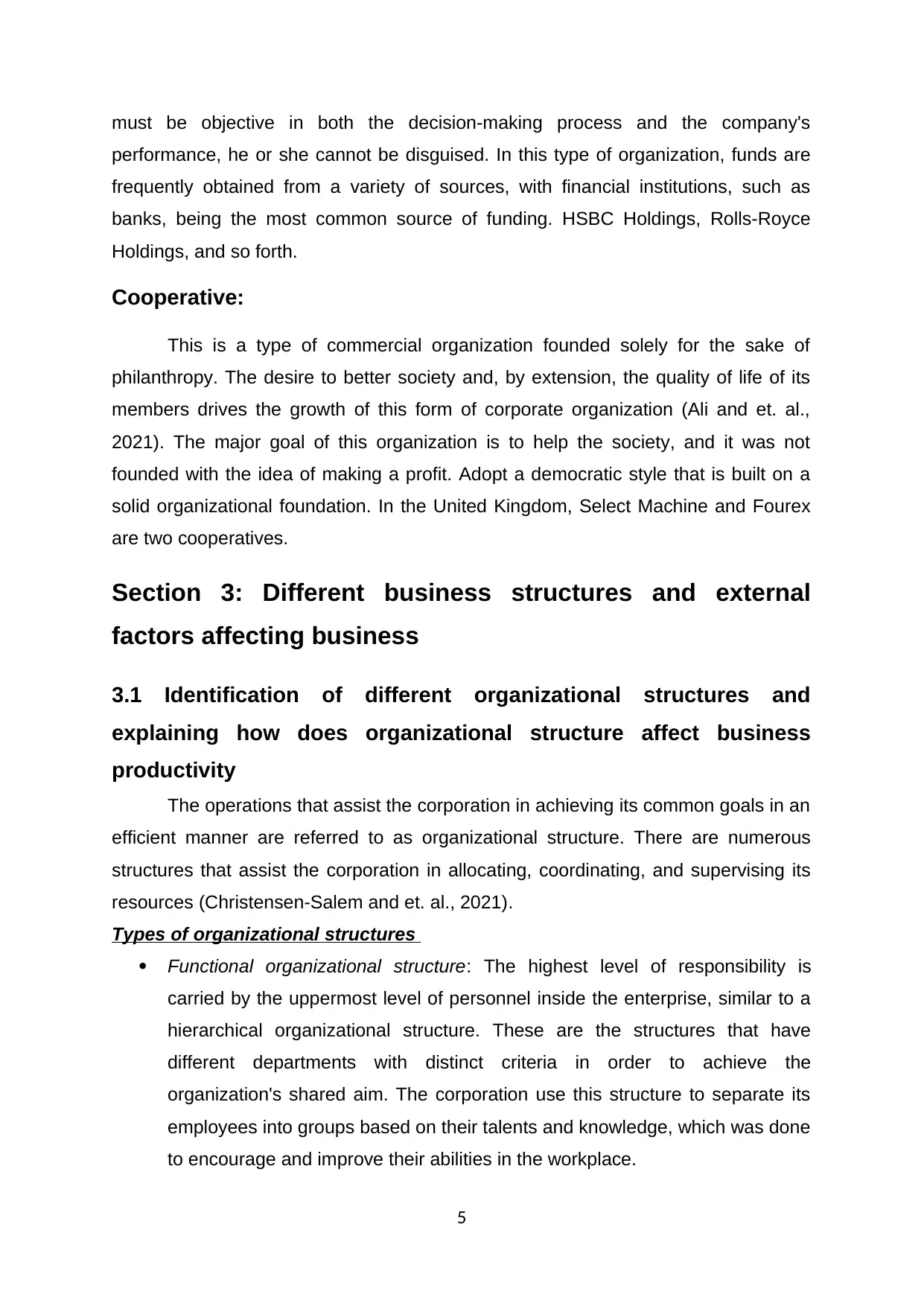
must be objective in both the decision-making process and the company's
performance, he or she cannot be disguised. In this type of organization, funds are
frequently obtained from a variety of sources, with financial institutions, such as
banks, being the most common source of funding. HSBC Holdings, Rolls-Royce
Holdings, and so forth.
Cooperative:
This is a type of commercial organization founded solely for the sake of
philanthropy. The desire to better society and, by extension, the quality of life of its
members drives the growth of this form of corporate organization (Ali and et. al.,
2021). The major goal of this organization is to help the society, and it was not
founded with the idea of making a profit. Adopt a democratic style that is built on a
solid organizational foundation. In the United Kingdom, Select Machine and Fourex
are two cooperatives.
Section 3: Different business structures and external
factors affecting business
3.1 Identification of different organizational structures and
explaining how does organizational structure affect business
productivity
The operations that assist the corporation in achieving its common goals in an
efficient manner are referred to as organizational structure. There are numerous
structures that assist the corporation in allocating, coordinating, and supervising its
resources (Christensen-Salem and et. al., 2021).
Types of organizational structures
Functional organizational structure: The highest level of responsibility is
carried by the uppermost level of personnel inside the enterprise, similar to a
hierarchical organizational structure. These are the structures that have
different departments with distinct criteria in order to achieve the
organization's shared aim. The corporation use this structure to separate its
employees into groups based on their talents and knowledge, which was done
to encourage and improve their abilities in the workplace.
5
performance, he or she cannot be disguised. In this type of organization, funds are
frequently obtained from a variety of sources, with financial institutions, such as
banks, being the most common source of funding. HSBC Holdings, Rolls-Royce
Holdings, and so forth.
Cooperative:
This is a type of commercial organization founded solely for the sake of
philanthropy. The desire to better society and, by extension, the quality of life of its
members drives the growth of this form of corporate organization (Ali and et. al.,
2021). The major goal of this organization is to help the society, and it was not
founded with the idea of making a profit. Adopt a democratic style that is built on a
solid organizational foundation. In the United Kingdom, Select Machine and Fourex
are two cooperatives.
Section 3: Different business structures and external
factors affecting business
3.1 Identification of different organizational structures and
explaining how does organizational structure affect business
productivity
The operations that assist the corporation in achieving its common goals in an
efficient manner are referred to as organizational structure. There are numerous
structures that assist the corporation in allocating, coordinating, and supervising its
resources (Christensen-Salem and et. al., 2021).
Types of organizational structures
Functional organizational structure: The highest level of responsibility is
carried by the uppermost level of personnel inside the enterprise, similar to a
hierarchical organizational structure. These are the structures that have
different departments with distinct criteria in order to achieve the
organization's shared aim. The corporation use this structure to separate its
employees into groups based on their talents and knowledge, which was done
to encourage and improve their abilities in the workplace.
5
⊘ This is a preview!⊘
Do you want full access?
Subscribe today to unlock all pages.

Trusted by 1+ million students worldwide
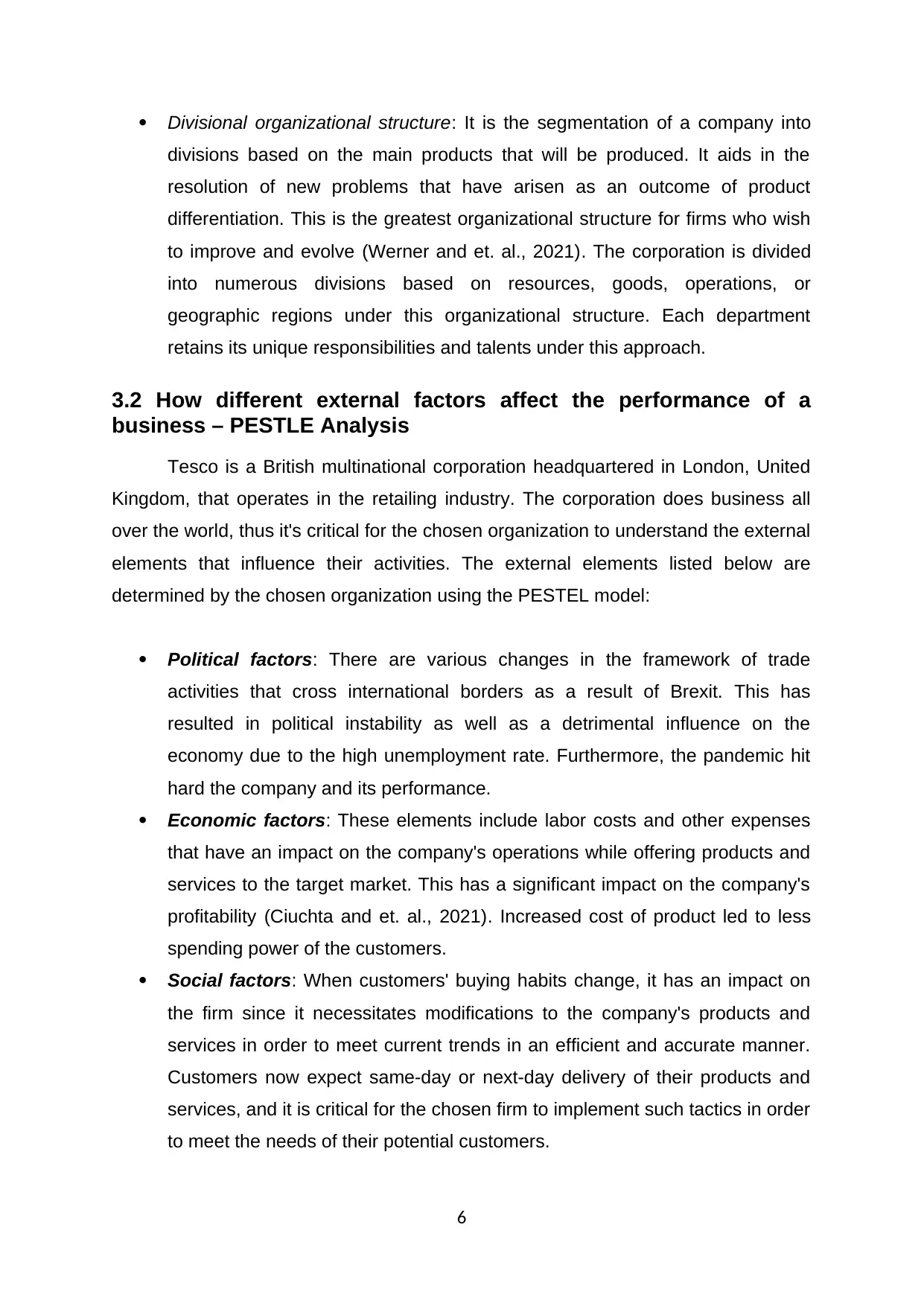
Divisional organizational structure: It is the segmentation of a company into
divisions based on the main products that will be produced. It aids in the
resolution of new problems that have arisen as an outcome of product
differentiation. This is the greatest organizational structure for firms who wish
to improve and evolve (Werner and et. al., 2021). The corporation is divided
into numerous divisions based on resources, goods, operations, or
geographic regions under this organizational structure. Each department
retains its unique responsibilities and talents under this approach.
3.2 How different external factors affect the performance of a
business – PESTLE Analysis
Tesco is a British multinational corporation headquartered in London, United
Kingdom, that operates in the retailing industry. The corporation does business all
over the world, thus it's critical for the chosen organization to understand the external
elements that influence their activities. The external elements listed below are
determined by the chosen organization using the PESTEL model:
Political factors: There are various changes in the framework of trade
activities that cross international borders as a result of Brexit. This has
resulted in political instability as well as a detrimental influence on the
economy due to the high unemployment rate. Furthermore, the pandemic hit
hard the company and its performance.
Economic factors: These elements include labor costs and other expenses
that have an impact on the company's operations while offering products and
services to the target market. This has a significant impact on the company's
profitability (Ciuchta and et. al., 2021). Increased cost of product led to less
spending power of the customers.
Social factors: When customers' buying habits change, it has an impact on
the firm since it necessitates modifications to the company's products and
services in order to meet current trends in an efficient and accurate manner.
Customers now expect same-day or next-day delivery of their products and
services, and it is critical for the chosen firm to implement such tactics in order
to meet the needs of their potential customers.
6
divisions based on the main products that will be produced. It aids in the
resolution of new problems that have arisen as an outcome of product
differentiation. This is the greatest organizational structure for firms who wish
to improve and evolve (Werner and et. al., 2021). The corporation is divided
into numerous divisions based on resources, goods, operations, or
geographic regions under this organizational structure. Each department
retains its unique responsibilities and talents under this approach.
3.2 How different external factors affect the performance of a
business – PESTLE Analysis
Tesco is a British multinational corporation headquartered in London, United
Kingdom, that operates in the retailing industry. The corporation does business all
over the world, thus it's critical for the chosen organization to understand the external
elements that influence their activities. The external elements listed below are
determined by the chosen organization using the PESTEL model:
Political factors: There are various changes in the framework of trade
activities that cross international borders as a result of Brexit. This has
resulted in political instability as well as a detrimental influence on the
economy due to the high unemployment rate. Furthermore, the pandemic hit
hard the company and its performance.
Economic factors: These elements include labor costs and other expenses
that have an impact on the company's operations while offering products and
services to the target market. This has a significant impact on the company's
profitability (Ciuchta and et. al., 2021). Increased cost of product led to less
spending power of the customers.
Social factors: When customers' buying habits change, it has an impact on
the firm since it necessitates modifications to the company's products and
services in order to meet current trends in an efficient and accurate manner.
Customers now expect same-day or next-day delivery of their products and
services, and it is critical for the chosen firm to implement such tactics in order
to meet the needs of their potential customers.
6
Paraphrase This Document
Need a fresh take? Get an instant paraphrase of this document with our AI Paraphraser
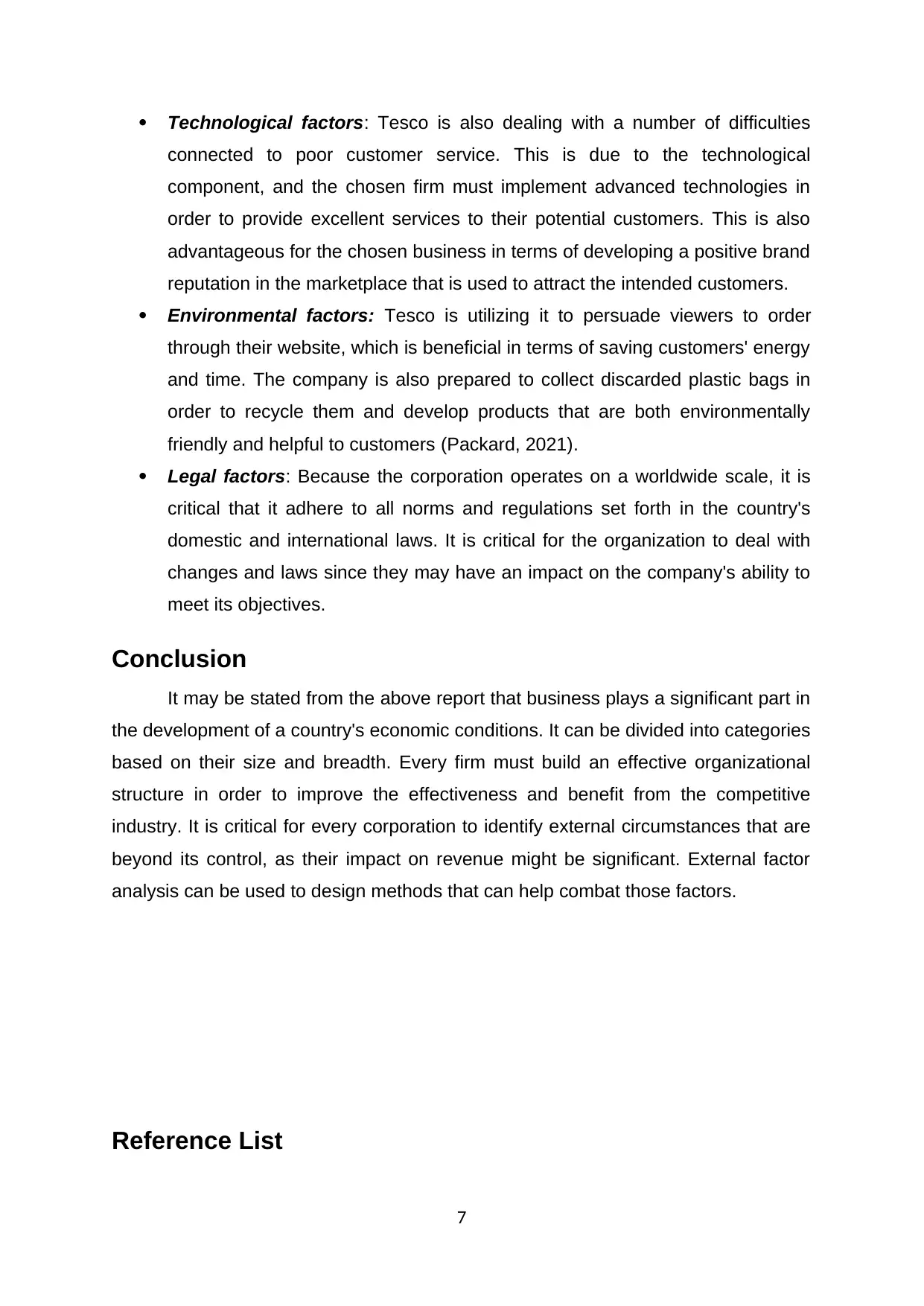
Technological factors: Tesco is also dealing with a number of difficulties
connected to poor customer service. This is due to the technological
component, and the chosen firm must implement advanced technologies in
order to provide excellent services to their potential customers. This is also
advantageous for the chosen business in terms of developing a positive brand
reputation in the marketplace that is used to attract the intended customers.
Environmental factors: Tesco is utilizing it to persuade viewers to order
through their website, which is beneficial in terms of saving customers' energy
and time. The company is also prepared to collect discarded plastic bags in
order to recycle them and develop products that are both environmentally
friendly and helpful to customers (Packard, 2021).
Legal factors: Because the corporation operates on a worldwide scale, it is
critical that it adhere to all norms and regulations set forth in the country's
domestic and international laws. It is critical for the organization to deal with
changes and laws since they may have an impact on the company's ability to
meet its objectives.
Conclusion
It may be stated from the above report that business plays a significant part in
the development of a country's economic conditions. It can be divided into categories
based on their size and breadth. Every firm must build an effective organizational
structure in order to improve the effectiveness and benefit from the competitive
industry. It is critical for every corporation to identify external circumstances that are
beyond its control, as their impact on revenue might be significant. External factor
analysis can be used to design methods that can help combat those factors.
Reference List
7
connected to poor customer service. This is due to the technological
component, and the chosen firm must implement advanced technologies in
order to provide excellent services to their potential customers. This is also
advantageous for the chosen business in terms of developing a positive brand
reputation in the marketplace that is used to attract the intended customers.
Environmental factors: Tesco is utilizing it to persuade viewers to order
through their website, which is beneficial in terms of saving customers' energy
and time. The company is also prepared to collect discarded plastic bags in
order to recycle them and develop products that are both environmentally
friendly and helpful to customers (Packard, 2021).
Legal factors: Because the corporation operates on a worldwide scale, it is
critical that it adhere to all norms and regulations set forth in the country's
domestic and international laws. It is critical for the organization to deal with
changes and laws since they may have an impact on the company's ability to
meet its objectives.
Conclusion
It may be stated from the above report that business plays a significant part in
the development of a country's economic conditions. It can be divided into categories
based on their size and breadth. Every firm must build an effective organizational
structure in order to improve the effectiveness and benefit from the competitive
industry. It is critical for every corporation to identify external circumstances that are
beyond its control, as their impact on revenue might be significant. External factor
analysis can be used to design methods that can help combat those factors.
Reference List
7
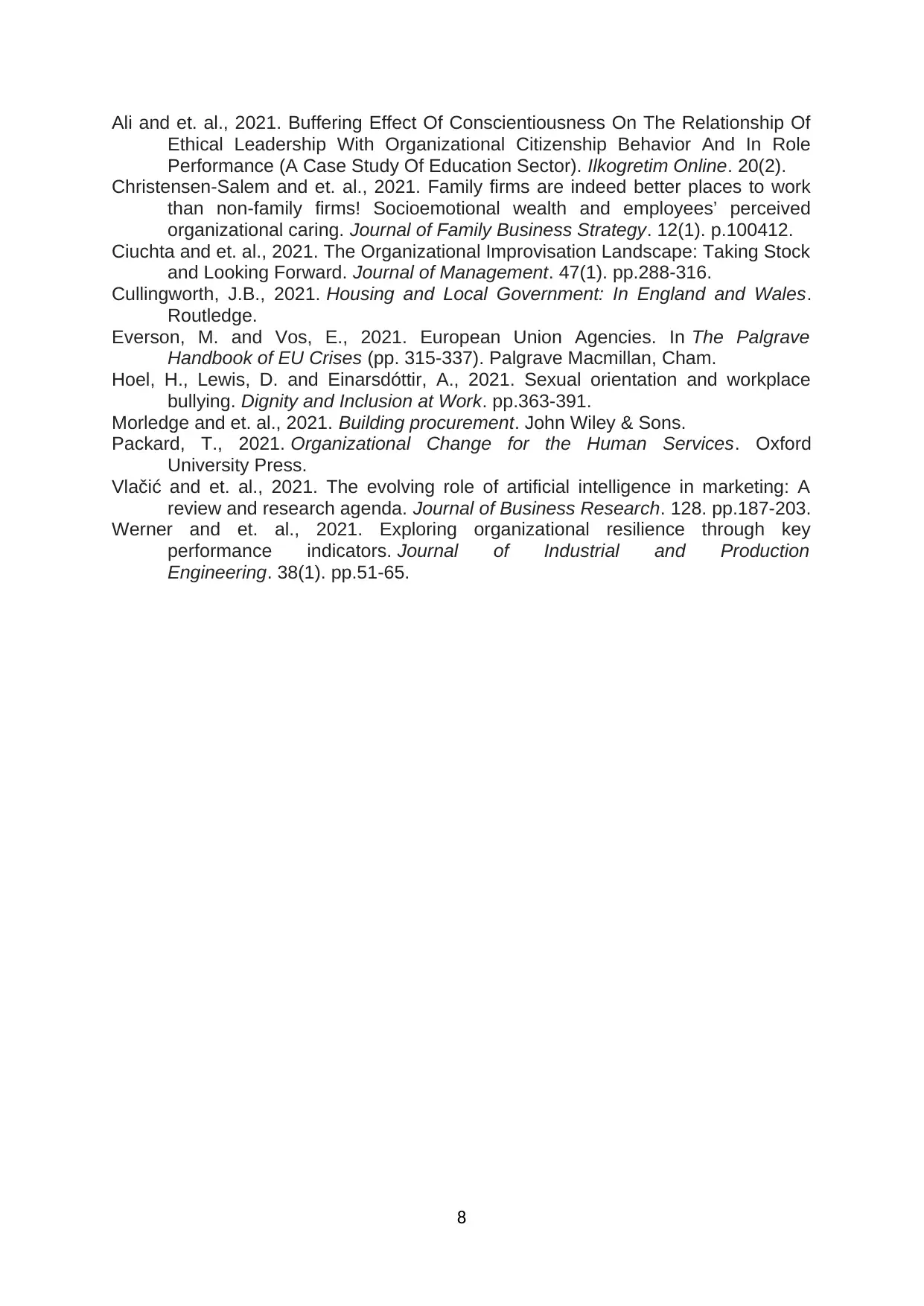
Ali and et. al., 2021. Buffering Effect Of Conscientiousness On The Relationship Of
Ethical Leadership With Organizational Citizenship Behavior And In Role
Performance (A Case Study Of Education Sector). Ilkogretim Online. 20(2).
Christensen-Salem and et. al., 2021. Family firms are indeed better places to work
than non-family firms! Socioemotional wealth and employees’ perceived
organizational caring. Journal of Family Business Strategy. 12(1). p.100412.
Ciuchta and et. al., 2021. The Organizational Improvisation Landscape: Taking Stock
and Looking Forward. Journal of Management. 47(1). pp.288-316.
Cullingworth, J.B., 2021. Housing and Local Government: In England and Wales.
Routledge.
Everson, M. and Vos, E., 2021. European Union Agencies. In The Palgrave
Handbook of EU Crises (pp. 315-337). Palgrave Macmillan, Cham.
Hoel, H., Lewis, D. and Einarsdóttir, A., 2021. Sexual orientation and workplace
bullying. Dignity and Inclusion at Work. pp.363-391.
Morledge and et. al., 2021. Building procurement. John Wiley & Sons.
Packard, T., 2021. Organizational Change for the Human Services. Oxford
University Press.
Vlačić and et. al., 2021. The evolving role of artificial intelligence in marketing: A
review and research agenda. Journal of Business Research. 128. pp.187-203.
Werner and et. al., 2021. Exploring organizational resilience through key
performance indicators. Journal of Industrial and Production
Engineering. 38(1). pp.51-65.
8
Ethical Leadership With Organizational Citizenship Behavior And In Role
Performance (A Case Study Of Education Sector). Ilkogretim Online. 20(2).
Christensen-Salem and et. al., 2021. Family firms are indeed better places to work
than non-family firms! Socioemotional wealth and employees’ perceived
organizational caring. Journal of Family Business Strategy. 12(1). p.100412.
Ciuchta and et. al., 2021. The Organizational Improvisation Landscape: Taking Stock
and Looking Forward. Journal of Management. 47(1). pp.288-316.
Cullingworth, J.B., 2021. Housing and Local Government: In England and Wales.
Routledge.
Everson, M. and Vos, E., 2021. European Union Agencies. In The Palgrave
Handbook of EU Crises (pp. 315-337). Palgrave Macmillan, Cham.
Hoel, H., Lewis, D. and Einarsdóttir, A., 2021. Sexual orientation and workplace
bullying. Dignity and Inclusion at Work. pp.363-391.
Morledge and et. al., 2021. Building procurement. John Wiley & Sons.
Packard, T., 2021. Organizational Change for the Human Services. Oxford
University Press.
Vlačić and et. al., 2021. The evolving role of artificial intelligence in marketing: A
review and research agenda. Journal of Business Research. 128. pp.187-203.
Werner and et. al., 2021. Exploring organizational resilience through key
performance indicators. Journal of Industrial and Production
Engineering. 38(1). pp.51-65.
8
⊘ This is a preview!⊘
Do you want full access?
Subscribe today to unlock all pages.

Trusted by 1+ million students worldwide
1 out of 9
Related Documents
Your All-in-One AI-Powered Toolkit for Academic Success.
+13062052269
info@desklib.com
Available 24*7 on WhatsApp / Email
![[object Object]](/_next/static/media/star-bottom.7253800d.svg)
Unlock your academic potential
Copyright © 2020–2025 A2Z Services. All Rights Reserved. Developed and managed by ZUCOL.



